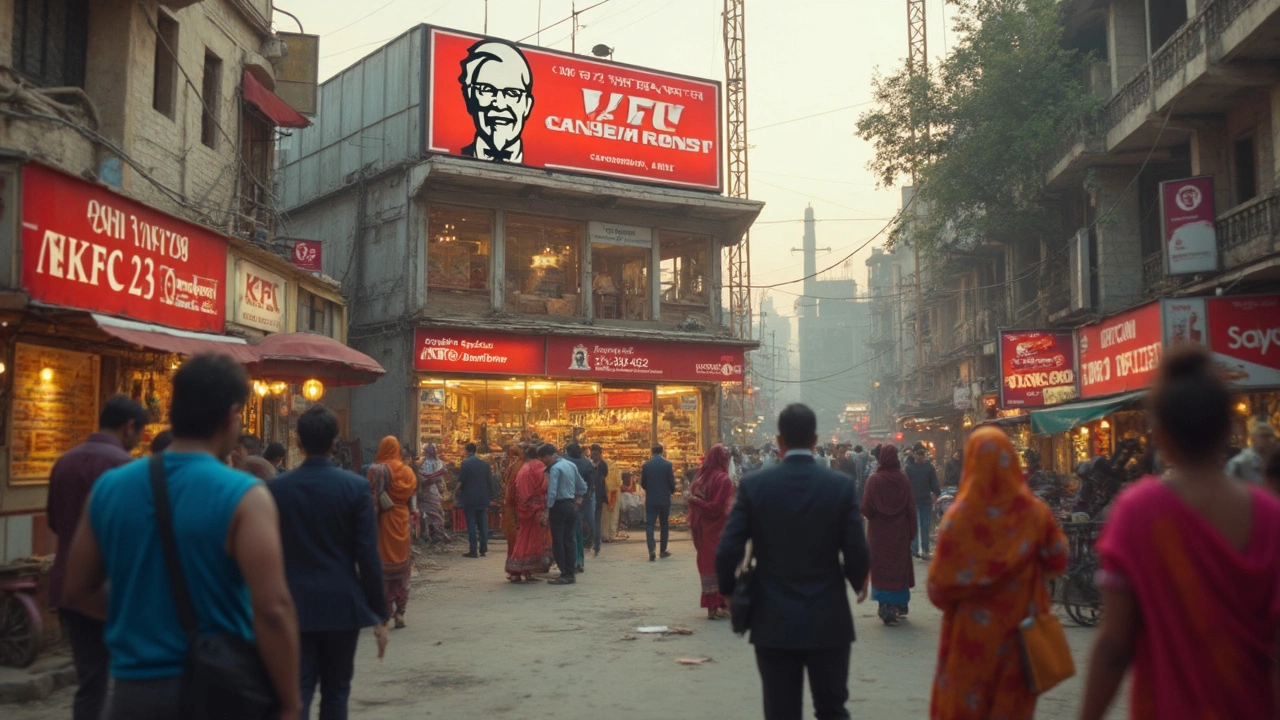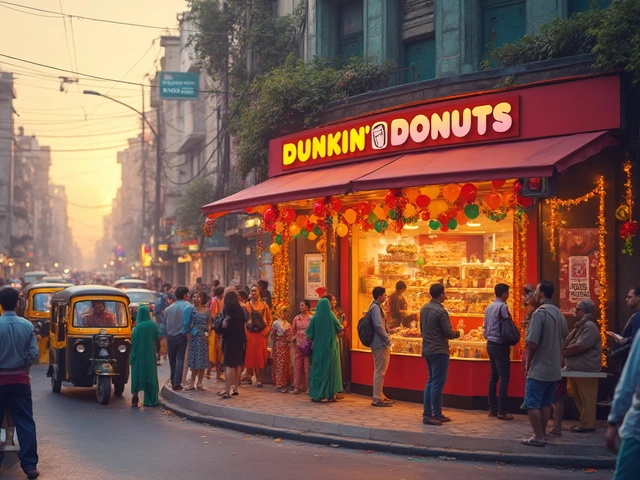Think starting a KFC in India sounds like easy money? The truth is, you’ll need a fat wallet and lots of patience. Opening a KFC franchise isn’t like running a corner tea stall—it’s a massive investment, and the money needed will probably surprise you.
First off, there’s no direct walk-in option. KFC in India works through its parent company, Yum! Brands, and you must go through a strict selection process. They don’t hand out franchises to just anyone with cash; they want serious business people with solid restaurant experience and a good location. So, before even thinking about the money part, check if you tick their boxes.
On to the main question—how much cash do you actually need? The honest answer: expect to cough up anywhere between ₹1.5 to ₹3 crore for a standard KFC outlet. And don’t forget the upfront franchise fee, which usually sits around ₹36-40 lakhs. Not included? The rental deposit, staff salaries, and heaps of other small but regular costs. This isn’t a small-time gamble—it’s a major commitment.
- Understanding KFC's Franchise Model in India
- Initial Franchise Fees and Legal Stuff
- Setup Costs: Infrastructure, Equipment, and Interiors
- Other Hidden or Ongoing Expenses
- Profit Expectations and When You Actually See Returns
- Tips for Making Your KFC Franchise Work in India
Understanding KFC's Franchise Model in India
Opening a KFC in India isn’t as easy as just filling out a form and cutting a cheque. KFC uses a very selective franchise model here, run through Yum! Brands—the same company behind Pizza Hut and Taco Bell. They don’t give out a KFC franchise India opportunity to just anyone. You need a business background and deep pockets.
KFC doesn’t run on the single store operator system that you see with smaller chains. Instead, they mostly work with big, regional players called “master franchisees” who run multiple stores across cities or even states. So, if you’re hoping to open just one small fried chicken joint, you’ll probably be disappointed. They want partners who can commit to opening several outlets and have experience running large food or retail chains.
Here’s a quick look at how it works:
- KFC picks franchise partners after a serious vetting process. They look at your net worth, your management experience, and whether you already have experience in the food business. Usually, they want you to have run other branded restaurant chains, or at least multi-unit operations.
- If you qualify, you’ll work with them to pick the location, follow their set menus, and use their supply chains. They don’t leave much to personal taste—you have to stick to KFC’s playbook for everything from staff uniforms to sauces.
- No “owner-operators” here. You’ll be running a corporate-style, standardized operation. That’s part of the reason KFC tastes the same in Mumbai, Delhi, or Bangalore.
To give you an idea of who’s in the game, here’s a quick data table of KFC’s key master franchisees and their area of operation as of 2024:
| Franchise Partner | Key Regions | # of Outlets (Approx.) |
|---|---|---|
| Devyani International Ltd. | North & East India | 515 |
| Sapphire Foods India | South & West India | 350 |
| Bursting onto scene (2023) | Tier 2 cities—expansion push | 100+ |
So, your best chances? Either approach as a seasoned investor with the muscle to expand or network with these big regional companies. Small players rarely stand a chance. The takeaway: if you want to break into the KFC game, be ready for big numbers, strict controls, and tough competition for a place at the table.
Initial Franchise Fees and Legal Stuff
Getting started with a KFC franchise India means tackling a bunch of upfront costs and paperwork, not just opening your wallet. The big chunk right at the start is the franchise fee. As of early 2025, KFC’s initial franchise fee sits around ₹36 to ₹40 lakh in India. This isn’t refundable. It buys you the rights to their brand, access to best-selling menus, and ongoing support, but not much else financially.
Don’t expect to just pay and get going. After the fee, you’ll need to enter into a franchise agreement with Yum! Restaurants. This legal contract is loaded with terms on how you run the place, what you can sell, and how KFC checks quality standards. Legal costs for reviewing the agreement and getting necessary signatures often run another ₹1-2 lakh, depending on your lawyer and any tweaks you need.
Here’s where it gets real—government approvals. You need:
- Food Safety and Standards Authority of India (FSSAI) license
- Shop and Establishment Act registration
- GST registration
- Local municipal health permits
- Fire safety certificate
Each of these isn’t super expensive alone (mostly ₹5,000–₹50,000 each), but together, it adds up and takes weeks, sometimes months, to sort out. KFC wants you to have all these in place before you open—no cutting corners.
Don’t skip the hidden stuff: security deposits (one to three months’ rent upfront if you’re leasing), business insurance, and the cost of making your business a Private Limited Company (if you’re serious, KFC will expect it). That’s another ₹2-4 lakh, easy, and lots more paperwork.
| Expense | Estimated Cost (INR) |
|---|---|
| Franchise Fee | 36–40 lakh |
| Legal/Agreement Drafting | 1–2 lakh |
| Licenses and Permits | 50,000–2 lakh |
| Company Registration | 1–2 lakh |
| Security Deposit | 2–5 lakh |
If you want to move fast, talk to someone who’s done this before—a franchise consultant or a lawyer who gets the F&B industry in India. It saves you cash (and headaches) down the line. Skip this, and you’ll risk breaking a rule you didn’t even know about.
Setup Costs: Infrastructure, Equipment, and Interiors
Here comes the price shock for most people looking into the KFC franchise India dream. Your big investment isn’t just for that bright KFC sign outside. Setting up shop means you’ll spend crores before you even serve your first Zinger.
Let’s break it down. The biggest chunk of change usually goes into the physical space. This could be anywhere from 1,000 to 1,500 square feet for a standard restaurant. In major cities, the rent deposit alone can hit ₹20 lakhs or more upfront. Remodeling the space to fit KFC’s strict branding and kitchen requirements often tops ₹90 lakhs. Think of premium flooring, custom counters, fire safety systems, lighting, signage, and air conditioning. They want every crate of fries and every bucket of chicken to feel exactly like any other KFC, anywhere in the world.
Equipment is another monster cost. The kitchen has to be loaded with commercial-grade fryers, chillers, walk-in freezers, industrial ovens, ventilation, and water systems. You’re looking at ₹35-40 lakhs just for the kitchen gadgets. And don’t skip—KFC audits everything, and you’ll need to stick to their approved suppliers.
The interiors take the experience up a notch. KFC’s new outlets focus a lot on customer comfort and Instagram-worthy vibes. This means trendy furniture, digital menu displays, top-grade tiles, brand-splashed wallpapers, and even special lighting setups. Interiors and décor usually set owners back anywhere from ₹20-30 lakhs, depending on how fancy (or basic) you go and your city’s real estate rates.
- If you’re opening in a mall or airport, expect to pay extra for fit-outs to match their rules too.
- Every square foot counts in your final bill; bigger store, higher costs.
- Don’t forget KFC’s surveillance systems and IT requirements—these can add a few lakhs more.
The bottom line: By the time you include infrastructure, equipment, fit-outs, and the small add-ons KFC wants, the setup bill alone can cross ₹1.5-2 crore, easy. So, check your budget—this step can’t be skipped.

Other Hidden or Ongoing Expenses
So you’ve paid the big upfront fees—now what? The actual cost of owning a KFC franchise India really starts to show after the ribbon-cutting. These ongoing expenses catch a lot of new owners off guard because they add up pretty fast every single month.
First, KFC’s royalty fees aren’t exactly loose change. You’ll pay around 6% of your monthly gross sales straight to the brand, and there’s usually another 5% for national advertising. This means before you even touch a rupee of profit, 11% of your sales are already spoken for.
Here’s what else keeps draining your account, month after month:
- Supply and inventory: You can’t just buy chicken from the local market. KFC demands you stick to their approved suppliers, who usually charge more, but you have no choice.
- Staff wages and training: Fast food means lots of staff. In big cities, paying decent salaries and managing benefits eats up a chunk of your budget, and you’ll spend plenty on training to meet KFC standards.
- Utilities: Air-conditioning, lighting, and heavy kitchen equipment mean electricity bills that can really sting, especially if you’re running a big outlet in a metro city.
- Maintenance and repairs: Regular servicing for fryers, ovens, and other fancy KFC equipment is non-negotiable. Fixing any breakdowns is on you.
- Marketing at the local level: While some promotion is national, getting local customers in the door usually means more spending on flyers, events, or online ads—coming straight out of your pocket.
- Licenses and yearly renewals: You’ll need to stay on top of food safety, health, and fire license renewals, all with their own hidden costs and paperwork headaches.
Most KFC owners say that to keep the outlet running smoothly and up to brand standards, you need to factor in at least ₹3-5 lakh a month above staff costs for these recurring expenses. Missing these numbers in your prep means nasty surprises down the line. Ongoing expenses can make or break your margins, so get your calculator ready before you jump in.
Profit Expectations and When You Actually See Returns
Alright, so you’ve taken the leap and put down the cash for a KFC franchise India outlet. When do you finally see the money flowing back? Most new KFC outlets in India hit serious sales numbers, but getting into profit territory takes a bit of patience. For most owners, the official payback period tends to be between 3 and 5 years. That’s if everything goes smoothly.
What can you expect each month? On average, a well-located KFC store in a busy city brings in anywhere from ₹35 lakh to ₹45 lakh per month in gross revenue. Out of that, after paying for ingredients, staff, utility bills, and Yum! Brands’ royalty fees (which usually hover around 6% of sales), you’re looking at a monthly profit margin of roughly 10-15%. Not bad, but not all of it lands in your pocket immediately.
Let’s break it down with some numbers. Here’s a simple table based on typical figures for a KFC franchise in an urban area:
| Revenue/Expenses | Monthly (₹) |
|---|---|
| Gross Sales | 40,00,000 |
| Operating Costs (food, staff, overhead) | 32,00,000 |
| Royalty & Ad Fees (6% + 5%) | 4,40,000 |
| Net Profit | 3,60,000 |
Those profits stack up slowly, given your initial investment is likely around ₹2 crore. If your outlet does better than average, you’ll clear your break-even point in just under three years. If sales are average or the area has heavy competition, five years is more realistic.
Don’t forget taxes and upkeep either. Maintenance, local licenses, and taxes can eat into your bottom line—but after year three, most owners finally see more comfortable profit, and some even open more outlets.
Two tips: Push hard on local promotions, and keep an eye on costs from day one. Extra marketing, good delivery options, and a sharp team will shave months off your payback period. But if you take your foot off the gas, that ROI will drag.
Tips for Making Your KFC Franchise Work in India
Just dumping money into a KFC franchise isn’t enough. Making it successful in the Indian market takes smarts, hustle, and a few tricks most new owners overlook. Let’s get into what actually works on the ground.
- KFC franchise India locations need constant footfall. Malls, busy main roads, and city centers bring in the crowds. The best-performing KFCs in India are nearly always inside or right outside major shopping areas or transport hubs.
- Don’t slack on the food quality or freshness. KFC’s reputation hinges on consistency. One off day can leave you with bad reviews that really hurt at the start.
- Keep an eye on local tastes. Spicy chicken items and veggie choices aren’t just nice-to-have—they’re expectations for customers here. KFC India does special menu items like the Paneer Zinger, and if you promote these locally, you’ll see results.
- Delivery and online orders now make up close to 35% of revenue for KFC India outlets. Partnering with Swiggy, Zomato, and running your own takeaway promos can keep cash flowing even if dine-in slows down.
- Staff training isn’t just a checkbox—well-trained staff cut down on waste, serve faster, and keep customers coming back. KFC’s training is strict for a reason: it helps protect the brand image and your sales.
- Use limited-time promos and meal combos. The ₹99 meal and similar offers are huge for KFC’s Indian franchisees. These grab attention, boost sales on weekdays, and make people walk in just for the value.
| Key Factor | Impact on Revenue |
|---|---|
| High-traffic location | +35-50% increase in sales over low-traffic areas |
| Online/Delivery Revenue Share | Up to 35% in metro cities |
| Weekend vs. Weekday Sales | Weekends can drive up to 60% of weekly sales |
| Menu Localisation | Adds 15-20% bump in local customer footfall |
Finally, keep a close eye on your monthly costs. KFC’s guidelines help, but things like power bills, AC maintenance, pest control, and rising food costs can eat away your profits in no time. Successful owners track these with apps or simple spreadsheets and respond fast.
If you tweak your approach for Indian customer habits — like late-night eating, love of spicy food, and regular discount hunting — you’ll give yourself a real shot at turning your franchise into a busy, steady business.


